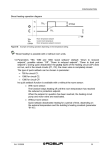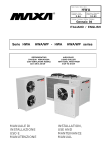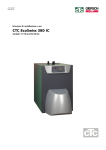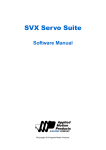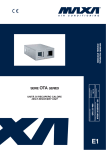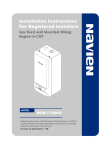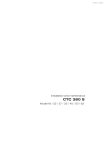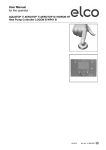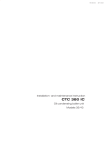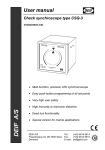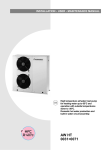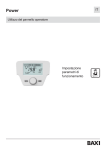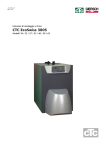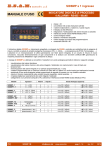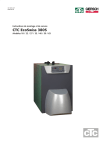Download Comfort Control Panel Installation, use and programming
Transcript
CCP.qxd 18-09-2009 10:20 Pagina 2 Installation, use and programming manual Comfort Control Panel E3 systems control device Revision: 12/2008 Code: D-LBR514 This booklet is authored and printed by Robur S.p.A; any form of even partial reproduction of this manual is forbidden. The original is archived at the premises of Robur S.p.A. Any use of the manual other than for consultation purposes must be authorized in advance by Robur S.p.A. The rights of the rightful owners of the registered trademarks included in this publication are protected. With the aim of continuously improving the quality of its products, Robur S.p.A. reserves the right to modify the data and contents of this manual without prior notice. INTRODUCTION PREFACE The present "Comfort Control Manual (Installation and Applications)" describes the parameters, their configuration and a number of example systems using Comfort Control equipment. This manual assumes that the reader is familiar with Robur products and with the information given in the manuals for the products to which it refers. This manual is specifically intended for: • designers for the design of systems using Robur series E3 modulating units controlled by Siemens Comfort Control equipment; • electrical installation technicians for the correct installation of control and monitoring equipment and devices; • installation technicians and Robur Technical Assistance Centres (TAC) for their correct configuration. The descriptions given in this manual refer to: • the RVS61 controller • the Siemens AVS37 interface • Robur series E3 units • the Comfort Control Interface (CCI). Summary The manual is divided into 9 sections and 5 annexes. References For requirements other than those illustrated in this manual, the user may have to configure the Comfort Control differently. Should this be necessary, refer to the following documentation: Comfort Control Panel - User Manual (D-LBR 523) (user’s version); Comfort Control Interface [CCI] (D-LBR 526) (installation and service technician’s version) Installation, user and maintenance manuals for series E3 (installation and service technician’s version) Ed. 12/2008 I Comfort Control Manual (Installation and Applications) The icons present in the margins of the manual have the following meanings: Danger warning WARNING note Start operating procedure Reference to another part of the manual or other manual Table 1 II Descriptive icons Ed. 12/2008 INDEX Summary PREFACE I SECTION 1 GENERAL INFORMATION ........................................................................... 3 SECTION 2 ASSEMBLY AND INSTALLATION ............................................................... 7 2.1 2.2 2.3 2.4 2.5 AVS37 CONTROL UNIT .................................................................................................................. 10 EXTERNAL AMBIENT SENSOR QAC34 ........................................................................................ 10 ROOM UNIT QAA55 ........................................................................................................................ 12 ROOM UNIT QAA75 ........................................................................................................................ 14 RADIO COMPONENTS ................................................................................................................... 15 2.5.1 RADIO MODULE AVS71.......................................................................................................... 16 2.5.2 ROOM UNIT QAA78 ................................................................................................................ 17 2.5.3 RADIO CONNECTION ............................................................................................................. 20 2.5.4 AVS13.399 EXTERNAL RADIO SENSOR............................................................................... 21 2.5.5 RADIO RELAY AVS14.390 ...................................................................................................... 23 2.6 EXPANSION MODULE .................................................................................................................... 25 SECTION 3 ELECTRICAL CONNECTIONS ................................................................... 27 3.1 3.2 3.3 ROOM UNIT CONNECTION ........................................................................................................... 27 TEMPERATURE SENSOR CONNECTION .................................................................................... 28 WATER CIRCULATION PUMP CONNECTION .............................................................................. 29 3.3.1 HEATING/CONDITIONING CIRCUIT PUMP 1 CONNECTION DIAGRAM ............................ 29 3.3.2 HEATING CIRCUIT PUMP 2 CONNECTION DIAGRAM ........................................................ 30 3.3.3 HEATING CIRCUIT PUMP CONNECTION DIAGRAM PUMP ................................................ 31 3.4 MIXER/DIVERTER VALVE CONNECTION ..................................................................................... 32 3.4.1 DIVERTER VALVES Y28 AND PUMP PY28 CONNECTION DIAGRAM ................................ 32 3.4.2 DIVERTER VALVES Q3 CONNECTION DIAGRAMOUT AND K6OUT ....................................... 33 3.4.3 MIXER VALVES Y1/Y2 AND Y5/Y6 CONNECTION DIAGRAM.............................................. 34 3.4.4 ROBUR BOILER ENABLE SIGNAL SCHEMATIC .................................................................. 35 SECTION 4 VALVE CONNECTIONS.............................................................................. 37 4.1 4.2 4.3 SIEMENS DIVERTER VALVES CONNECTION ............................................................................. 37 SIEMENS MIXER VALVE CONNECTION ....................................................................................... 42 VALVE ACTUATOR ORIENTATION DIAGRAM ............................................................................. 43 SECTION 5 COMMISSIONING ....................................................................................... 45 5.1 5.2 5.3 PREREQUISITES ............................................................................................................................ 45 OPERATING TEST .......................................................................................................................... 46 RVS61 CONTROLLER .................................................................................................................... 47 SECTION 6 SYSTEM BLOCKS ...................................................................................... 49 6.1 DESCRIPTION OF PARTS OF THE SYSTEM ............................................................................... 50 6.1.1 BASE BLOCK (BP) ................................................................................................................. 50 3 6.1.2 ROBUR BLOCK E .................................................................................................................. 51 6.1.3 BLOCK PC (PASSIVE COOLING) .......................................................................................... 52 6.1.4 BLOCK DHW ........................................................................................................................... 53 6.1.5 BLOCK B ................................................................................................................................. 54 6.1.6 BLOCK C1/C2 (MIX1/MIX2 CIRCUIT)..................................................................................... 55 6.1.7 BLOCK CP (PUMP CIRCUIT) ................................................................................................. 56 Ed. 12/2008 1 Comfort Control Manual (Installation and Applications) 6.1.8 BLOCK RU (ROOM UNIT).......................................................................................................57 SECTION 7 CONFIGURATION ...................................................................................... 59 7.1 7.2 7.3 7.4 7.5 7.6 7.7 BP - BASIC SYSTEM CONFIGURATION .......................................................................................60 3 E - ROBUR MACHINE CONFIGURATION ....................................................................................64 PC BLOCK SCHEMATIC .................................................................................................................68 DHW BLOCK CONFIGURATION ....................................................................................................69 B - BOILER CONFIGURATION FOR HEATING/DHW INTEGRATION TO HEAT PUMP ..............78 HEATING AND COOLING CIRCUIT CONFIGURATION ................................................................81 CONFIGURATION OF ROOM UNITS (RU) AND CONTROL UNITS FOR HEATING AND CONDITIONING CIRCUITS ...........................................................................................................106 SECTION 8 EXAMPLE INSTALLATIONS.................................................................... 117 8.1 SYSTEM EXAMPLE 1....................................................................................................................117 8.1.1 PLUMBING DIAGRAM ...........................................................................................................118 8.1.2 WIRING DIAGRAM ................................................................................................................119 8.1.3 UNIT BOARD CONFIGURATION ..........................................................................................121 8.1.4 COMFORT CONTROL CONFIGURATION ...........................................................................121 8.1.5 SYSTEM COMPONENTS ......................................................................................................121 8.1.6 CONFIGURATION OF THE COMFORT CONTROL INTERFACE [CCI] (D-LBR 526) ID:960124 8.2 SYSTEM EXAMPLE 2....................................................................................................................124 8.2.1 PLUMBING DIAGRAM ...........................................................................................................125 8.2.2 WIRING DIAGRAM ................................................................................................................126 8.2.3 UNIT BOARD CONFIGURATION ..........................................................................................128 8.2.4 COMFORT CONTROL CONFIGURATION ...........................................................................128 8.2.5 SYSTEM COMPONENTS ......................................................................................................128 8.2.6 CONFIGURATION OF THE COMFORT CONTROL INTERFACE [CCI] (D-LBR 526) ID:960134 SECTION 9 OTHER POSSIBLE SETTINGS ................................................................ 135 APPENDIX A - LEGEND AND TECHNICAL DATA ...................................................... 137 APPENDIX B - OOTHER USEFUL OEM PARAMETERS ............................................. 145 APPENDIX C - PARAMETERS OF USE IN TESTING THE SYSTEM: ......................... 147 APPENDIX D - TABLE OF ERROR CODES ................................................................. 151 APPENDIX E - ROBUR BASIC CONFIGURATIONS TABLE ....................................... 155 2 Ed. 12/2008 GENERAL INFORMATION SECTION 1 GENERAL INFORMATION In a system which includes series E3 equipment, controlled by the Comfort Control system, a system such as that shown in Figure 1 is possible. Comfort Control schematic Figure 1 Comfort Control system components Ed. 12/2008 3 Comfort Control Manual (Installation and Applications) Electrical panel Figure 2 4 Comfort Control Panel (CCP) layout Ed. 12/2008 GENERAL INFORMATION CCP wiring diagram Figure 3 Comfort Control Panel (CCP) wiring diagram Ed. 12/2008 5 Comfort Control Manual (Installation and Applications) 6 Ed. 12/2008 ASSEMBLY AND INSTALLATION SECTION 2 ASSEMBLY AND INSTALLATION This section explains how the equipment is to be assembled and installed. Before proceeding with the installation, make sure that the equipment is disconnected from the electrical power supply. Electrical connections to the main power circuit and low voltage circuit must be separate (the Robur CCP has 2 different routings for the two separate circuits). The cabling must be done in safety class II, so that the sensor and power cables may not be routed in the same duct. A single sensor may not be used for more than one input. The CCP and its accessory equipment may be powered up only on completion of the installation. Failure to observe this precaution can short circuit the equipment. The CCP may not be exposed to water. The ambient and operating temperature range is 0 to 50 °C Connection to main power supply Install_Tab_01 L N E9 E10 EX1 EX2 EX3 EX4 EX5 EX6 EX7 E11 K1 N Q3 N Q2 Y1 N Y2 N Use 230 V AC phase Ground Neutral Low pressure Not used High pressure (DHW with heat pump load interruption) EX1 multifunction input Not used EX2 multifunction input Not used EX3 multifunction input Not used EX4 multifunction input Not used EX5 multifunction input Not used EX6 multifunction input Not used EX7 multifunction input Not used Overload protection 1 Not used Level 1 compressor (Heat pump ON) Neutral Ground DHW load pump / diverter valve Neutral Ground Heating circuit pump 1 Heating circuit mixer valve 1 open Neutral Ground Heating circuit mixer valve 1 close Neutral Ed. 12/2008 Terminal L Type of connector AGP4S.03E/109 N K AGP4S.02J/109 P AGP8S.07A/109 Q AGP8S.02E/109 H AGP8S.03A/109 S AGP8S.03B/109 T AGP8S.04B/109 U AGP8S.03C/109 7 Comfort Control Manual (Installation and Applications) QX6 Use Ground Source pump (not used) Fan (No used) Neutral Ground Condensing pump (not used) Multifunction output 1 Neutral Ground Multifunction output 2 Neutral Ground Multifunction output 3 Neutral Ground Multifunction output 4 Multifunction output 5 Neutral Ground Multifunction output 6 Table 2 RVS61 output connections Q8 K19 N Q9 QX1 N QX2 N QX3 N QX4 QX5 N 8 Terminal Type of connector V AGP8S.03D/109 W AGP8S.04E/109 X AGP8S.03E/109 Y AGP8S.03G/109 Z AGP8S.04C/109 Ed. 12/2008 ASSEMBLY AND INSTALLATION Safe low voltage (SELV/PELV) connections Install_Tab_02 DB MB CL+ CLCL+ CLCL+ CLG+ H1 M H3 B81 M B3 M B9 M B21 M B1 M B71 M B91 M B84 B92 M BX1 M BX2 M BX3 M BX4 M BX5 M UX M Table 3 Use Service tool LPB Service tool BSB Radio module AVS71.390 Additional module AVS75.390 Service unit (HMI) LPB data bus LPB ground Room unit 3 data bus Room unit 3 ground Room unit 2 data bus Room unit 2 ground Room unit 1 data bus Room unit 1 ground Optional lighting power Digital input H1 / 0...10 V Ground Digital input H3 / 0...10 V Hot gas temperature sensor 1 (not used) Ground DHW temperature sensor Ground External temperature sensor Ground Heat pump delivery temperature sensor (not used) Ground HC1 delivery temperature sensor Ground Heat pump return temperature sensor Ground Source delivery temperature sensor Ground Evaporation temperature sensor Source return temperature sensor Ground Multifunction input 1 sensor Ground Multifunction input 2 sensor Ground Multifunction input 3 sensor Ground Multifunction input 4 sensor Ground Multifunction input 5 sensor Ground UX analogue multifunction output Ground Terminal LPB BSB X60 X50 X30 Type of connector AVS82.490/109 AVS82.491/109 a AGP4S.02H/109 b AGP4S.02A/109 b AGP4S.02 A /109 b AGP4S.03D/109 e AGP4S.03G/109 f AGP4S.02B/109 h AGP4S.02C/109 k AGP4S.02D/109 n AGP4S.02F/109 P AGP4S.02G/109 q AGP4S.02K/109 r AGP4S.02L/109 s AGP4S.02S/109 t AGP4S.02M/109 u AGP4S.02N/109 w AGP4S.02P/109 x AGP4S.02R/109 y AGP4S.02T/109 z AGP4S.02U/109 RVS61 input connections Ed. 12/2008 9 Comfort Control Manual (Installation and Applications) 2.1 AVS37 control unit Installation Figure 4 Installation method The AVS37.294 controller is already installed in the Robur panel (CCP) and connected to terminal X30 of the base unit via cable AVS82.491/109 (code Robur E-CVO246). As regards its use, refer to Comfort Control Panel - User Manual (D-LBR 523). 2.2 External ambient sensor QAC34 The external sensor is essential to the operation of the Comfort Control system. If this sensor is not connected to the RVS61 controller, the system does not operate. The sensor is used to acquire the external temperature and, for small extensions, accounts for sunlight, wind chill and the temperature of the wall to which it is mounted. Technical characteristics Type reference Sensing element NTC1000 QAC34/101 Ω at 25 °C Table 4 10 Measurement range °C -50...70 Tolerance K* ±1 Copper cable Time Weight Packing size mm² /cable constant (g) dia. Mm (min) 12 73 48 pieces individually packed in multipacks 1.5 / 7.2 QAC34/101 sensor characteristics * QAC34/101 AT -10...+20 °C Ed. 12/2008 Perm. cable length (m) 120 ASSEMBLY AND INSTALLATION Assembly and installation Installation Figure 5 Installing the QAC.34 external sensor Installation Figure 6 F-CC_0051 F-CC_0052 Dimensions of the QAC.34 external sensor Ed. 12/2008 11 Comfort Control Manual (Installation and Applications) 2.3 Room unit QAA55 Location Figure 7 Installation position of the QAA55 room unit. The room unit must be located in a reference room, generally the living room, bearing in mind the following factors: the room unit must be mounted 1.5 metres above the floor, in an area which enables the sensor to measure the ambient temperature as accurately as possible; hence, out of the way of draughts, direct sunlight and other heat sources. If wall mounted, sufficient space must be provided above the unit for installation and removal. The room unit, once removed from its base, is no longer powered up and hence is not operational. Installation Figure 8 Installation of the QAA55 room unit. The room unit may not be installed in areas exposed to water and humidity. 12 Ed. 12/2008 ASSEMBLY AND INSTALLATION Electrical connections Figure 9 Connection of the QAA55 room unit. T_CC_0024 Terminal Name QAA55 1 CL+ BSB data 2 CL- BSB ground Table 5 QAA55 room unit connections. Compare the connection diagram with paragraph 3.1 Room unit connection a pagina 27. Dimensions and drilling template Figure 10 QAA55 room unit drilling holes. As regards its use, refer to Comfort Control Panel - User Manual (D-LBR 523). Ed. 12/2008 13 Comfort Control Manual (Installation and Applications) 2.4 Room unit QAA75 Location Figure 11 Installation position of the QAA75 room unit. The room unit must be located in a reference room, generally the living room, bearing in mind the following factors: the room unit must be mounted 1.5 metres above the floor, in an area which enables the sensor to measure the ambient temperature as accurately as possible; hence, out of the way of draughts, direct sunlight and other heat sources. If wall mounted, sufficient space must be provided above the unit for installation and removal. The room unit, once removed from its base, is no longer powered up and hence is not operational. Installation Figure 12 14 Installation of the QAA75 room unit. Ed. 12/2008 ASSEMBLY AND INSTALLATION The room unit may not be installed in areas exposed to water and humidity. Electrical connections Terminal Name QAA75 1 CL+ BSB data 2 CL- BSB ground 3 G+ Power 12 V AC Table 6 QAA75/78 room unit connections. Compare the connection diagram with paragraph 3.1 Room unit connection a pagina 27 Dimensions and drilling template Figure 13 QAA75 room unit drilling holes. As regards its use, refer to Comfort Control Panel - User Manual (D-LBR 523). 2.5 Radio components The radio components must be installed so as to be as free as possible from interference, as follows: Away from electrical cabling, strong magnetic fields and equipment such as PC’s, TV’s, microwave ovens, etc. Away from large metal, glass and special concrete structures The distance from the transmitter may not exceed 30 metres or two storeys. Ed. 12/2008 15 Comfort Control Manual (Installation and Applications) 2.5.1 Radio module AVS71 The radio module expands our product range by offering the possibility of wireless communications. With the radio module, system components such as the room unit can transmit their data wirelessly. Installation Led Button Figure 14 Installation of the AVS71 radio module. Do not install the radio module inside a metal housing (e.g., inside the heat pump enclosure). Electrical connections The cable must be connected to regulator terminal X60. Before making the connection, make sure the base unit is not powered up. 16 Ed. 12/2008 ASSEMBLY AND INSTALLATION Dimensions and drilling template Figure 15 2.5.2 AVS71 radio module drilling holes. Room unit QAA78 Location Figure 16 Installation position of the QAA78 room unit. The room unit must be located in a reference room, generally the living room, bearing in mind the following factors: Ed. 12/2008 17 Comfort Control Manual (Installation and Applications) the room unit must be mounted 1.5 metres above the floor, in an area which enables the sensor to measure the ambient temperature as accurately as possible; hence, out of the way of draughts, direct sunlight and other heat sources. If wall mounted, sufficient space must be provided above the unit for installation and removal. The room unit, once removed from its base, is no longer powered up and hence is not operational. Installation with base Figure 17 18 Installation of the QAA78 room unit. Ed. 12/2008 ASSEMBLY AND INSTALLATION Installation without base Figure 18 Installation of the QAA78 room unit. The room unit may not be installed in areas exposed to water and humidity. The room unit is powered by three 1.5 V AA batteries (LR06). Dimensions and drilling template Figure 19 QAA78 room unit drilling holes. Ed. 12/2008 19 Comfort Control Manual (Installation and Applications) 2.5.3 Radio connection Before proceeding with the installation, connect the components to the radio module, so that after assembly, all system components are easily traceable. The essential condition for the wireless connection is that all components must receive the signal, in other words, the radio module must be correctly connected to the base unit and the batteries fitted in the room unit. 1. Press the radio module button for at least 8 seconds, until its led starts flashing quickly. 2. To enter the programming phase, press the OK button on the room unit. 3. Hold down the Info button for at least 3 seconds, then select “initial activation” with the programming knob and press OK. 4. Select the “Radio” menu and press OK. 5. Select “line 120”. Press OK to confirm. 6. Turn the knob to “YES” and press OK. The unit will now search for the wireless connection. 7. T The display shows the connection strength as a percentage. This can take from 2 to 120 seconds. 8. Once the connection has been established, the message “Unit ready” displays and the led stops flashing. Radio connection test Run the test to check the quality of the wireless connection. The test can be interrupted at any time by pressing ESC. While the radio connection can be initiated on the heat pump itself, the test must be run in the area in which the room unit is to be installed. Select the page “Radio” on the room unit (as explained above in steps 2 to 4) and activate Test mode on the line “Test mode” (line 121). During the test, the numbers on the left show the number of data packets sent, while those on the left show those received. The test stops after 24 packets and is considered passed if at least 50% of the packets have been sent and received successfully. If the test fails, find another location for the room unit or use radio relay AVS14.390. 20 Ed. 12/2008 ASSEMBLY AND INSTALLATION 2.5.4 AVS13.399 external radio sensor The transmitter must be installed inside the building It must be installed to enable easy replacement of its batteries. Installation Figure 20 Installing the external radio sensor. Connection C D A Legend: A: Batteries B: To remove the batteries B C: Button D: Led Figure 21 Installing the external radio sensor. Ed. 12/2008 21 Comfort Control Manual (Installation and Applications) The units must be connected via a two wire (exchangeable) cable. Power is supplied by two 1.5 V AAA batteries (LR03). Radio connection 1. Press the radio module button for at least 8 seconds, until its led starts flashing quickly. 2. Press the external radio sensor transmitter button for at least 8 seconds, until its led starts flashing quickly. 3. The connection has been established when the radio module led stops flashing. 4. Now press the button on the external radio sensor transmitter button briefly until the led stops flashing. Test: Run the test to check the quality of the wireless connection. The test can be interrupted at any time by pressing ESC. While the radio connection can be initiated on the heat pump itself, the test must be run in the area in which the room unit is to be installed. 1. Press button “C” Figure 21 on the external radio sensor transmitter for at most 8 seconds, until the led starts flashing slowly. 2. If radio communications are active, the radio module led lashes briefly at 10 second intervals. 3. Now press the button on the external radio sensor transmitter button briefly until the led stops flashing. 22 Ed. 12/2008 ASSEMBLY AND INSTALLATION Dimensions and drilling template Figure 22 2.5.5 External radio sensor drilling holes. Radio relay AVS14.390 To establish the radio connection, the device must be powered up temporarily before installation. The relay must be installed inside the building. Installation Figure 23 Installing the radio relay. Ed. 12/2008 23 Comfort Control Manual (Installation and Applications) Connections The consignment includes a power supply kit. The wires are interchangeable. Radio connections See Radio connection a pagina 22. Dimensions and drilling template Figure 24 24 Radio relay drilling holes. Ed. 12/2008 ASSEMBLY AND INSTALLATION 2.6 Expansion module The system can handle up to 2 expansions, which configure and control 2 heating circuits as follows: Heating circuit 2 (HC2) configured on expansion n. 2. Pump heating circuit (HCP) configured on expansion n. 1. Refer to the dipswitch positions shown in Figure 25 for the settings of expansion modules 1 and 2. Expansion module I/O = Module 1 = Module 2 Figure 25 Identification of modules 1 and 2 Ed. 12/2008 25 Comfort Control Manual (Installation and Applications) Connection to main power supply L N QX21 N QX22 N QX23 Table 7 Use 230 V AC phase Ground Neutral Open mixer valve Neutral Ground Close mixer valve Neutral Ground Heating circuit pump Terminal L Type of connector AGP4S.03E/109 N T AGP8S.04B/109 S AGP8S.03B/109 AVS75 expansion module output connections. Safe very low voltage connections Use X30 BX21 M BX22 M H2 M Table 8 26 Terminal Controller / Heat pump control panel Open mixer valve Ground Open mixer valve Ground DC digital input 0...10 V Ground Type of connector AVS82.491/109 n AGP4S.02F/109 n AGP4S.02F/109 n AGP4S.02F/109 AVS75 expansion module input connections Ed. 12/2008 ELECTRICAL CONNECTIONS SECTION 3 ELECTRICAL CONNECTIONS 3.1 Room unit connection Room unit connection diagram Figure 26 Example of backlighting connection on room unit (QAA75.. with backlighting) Backlighting (detail A in Figure 26) is only available on QAA75 units. Ed. 12/2008 27 Comfort Control Manual (Installation and Applications) 3.2 Temperature sensor connection Temperature sensor connection diagram Figure 27 28 Example connection of temperature sensor connection to RVS 61 and expansion module AVS75. Ed. 12/2008 ELECTRICAL CONNECTIONS 3.3 Water circulation pump connection 3.3.1 Heating/conditioning circuit pump 1 connection diagram Figure 28 Direct or externally relayed connection to heating/conditioning circuit pump on RVS61. Ed. 12/2008 29 Comfort Control Manual (Installation and Applications) 3.3.2 Heating circuit pump 2 connection diagram Figure 29 30 Direct or externally relayed connection to heating circuit 2 pump on expansion module n.2. Ed. 12/2008 ELECTRICAL CONNECTIONS 3.3.3 Heating circuit pump connection diagram Pump Figure 30 Direct or externally relayed connection to heating circuit P pump on expansion module n.1. Ed. 12/2008 31 Comfort Control Manual (Installation and Applications) 3.4 Mixer/diverter valve connection 3.4.1 Diverter valves Y28 and pump PY28 connection diagram Figure 31 32 Blue Blue Brown Black Brown Blue Brown Blue Brown Black Black Black Direct and relayed connection of diverter valves Y28 and pump PY28 Ed. 12/2008 ELECTRICAL CONNECTIONS 3.4.2 Diverter valves Q3 connection diagramOUT and K6OUT Blue Brown Black Figure 32 Blue Blue Brown Brown Black Black Diverter valves Q3 connectionOUT and K6OUT directly from PLC Ed. 12/2008 33 Comfort Control Manual (Installation and Applications) 3.4.3 Mixer valves Y1/Y2 and Y5/Y6 connection diagram Figure 33 34 Mixer valves Y1/Y2 (circuit C1) and Y5/Y6 (circuit C2) connection Ed. 12/2008 ELECTRICAL CONNECTIONS 3.4.4 Robur boiler enable signal schematic Boiler enable signal (voltage free contact) Figure 34 Heating/DHW supplementary boiler On/Off signal connection. Ed. 12/2008 35 Comfort Control Manual (Installation and Applications) 36 Ed. 12/2008 VALVE CONNECTIONS SECTION 4 VALVE CONNECTIONS 4.1 Siemens diverter valves connection Figure 35 Location of diverter/mixer valves in system Ed. 12/2008 37 Comfort Control Manual (Installation and Applications) The Siemens diverter valve body is marked with B and AB reversed from the normal markings. Thus the common way is marked B, as shown in the schematics given below. When mounting the valve, make sure to mount it in the orientation shown in the figures given below. The following figures give the connections for each type of valve installed. Failure to observe these indications can compromise the initial activation of the system. Contact Robur in case of doubt. Diverter valve Q3 connection diagramout (if DHW block present) 5 Heating delivery Delivery DHW A AB B Delivery E3 (hot side) Figure 36 Description of direction of flow of valve n. 5 shown in Figure 35. Diverter valves K6 connection diagramout (if B and DHW blocks present) 1 2 Heating delivery Delivery DHW A A AB AB Heating return B Boiler delivery Figure 37 38 DHW return B Boiler return Description of direction of flow of valves n.1 and 2 shown in Figure 35. Ed. 12/2008 VALVE CONNECTIONS Diverter valves Y28 connection diagram (if PC block is present) 3 4 PC exchanger inlet Delivery to well / acquifer A Delivery E3 / output Q3 (A) A AB B Pump Y28 delivery Heating delivery to service Figure 38 AB B Delivery E3 (cold side) Description of direction of flow of valves n.3 and 4 shown in Figure 35. Installing the Siemens I/SBC28.2 actuator 1. Rotate the valve rod (detail 1) so that the point of the arrow is opposite the side of the valve body (detail 3) marked with A, B and AB. (see Figure 39). 2. Remove the actuator bushing (I/SBSC28.2) and fit it to the rod (detail 1 of Figure 39). 3. Press the “release button” and set the actuator pointer to “Close” (see Figure 40). 4. Fit the actuator to the valve body (detail 3) and secure it to its bracket (detail 2) (see Figure 39). If for any reason it is not possible to mount the actuator, rotate the bracket (detail 2 of Figure 39) through 90°. Ed. 12/2008 39 Comfort Control Manual (Installation and Applications) I/SBC28.2 actuator installation diagram A AB B 1 2 A Figure 39 B 3 AB Actuator mounting diagram. Detail 1: valve actuator control rod. Detail 2: actuator bracket. Detail 3: valve body (plane view). I/SBC28.2 actuator Close pointer Release button Open Figure 40 40 Description of actuator: The “pointer” indicates and controls the position of the actuator in Figure 39, the “release button” is used for moving the “pointer” by hand. Ed. 12/2008 VALVE CONNECTIONS DIVERTER VALVE TECHNICAL DATA VALVE BODY Operating pressure PN16 FOR HOT WATER AT 90°C. PN 2 0 FOR COLD WATER Fluid temperature WATER 0°C…90°C Angle of rotation 90° VALVE ACTUATOR Electrical power Frequency Peak consumption Stroke time (open/close) Auxiliary contact rating Admitted ambient temperature Admitted ambient humidity Degree of protection cable (with auxiliary contact) Weight I/SBC28.2.3 230V AC, + 10% - 15% 50 HZ SUPPLY 4 VA 90‘‘ FOR 1¼’’ AND 180’’ FOR 1½‘’ AND 2’’ 250V 3A (RESISTIVE) DURING OPERATION: 0…+ 50°C SHIPPING AND STORAGE: -10…+80°C CLASS G, DIN40040 IP 54 6 x 1 mm2, length 0.8 m 0.45 KG Diverter valves internal electrical connection (Q3out, K6out, Y28) Legend: Brown: line Black: Connect to controller output terminal powered: valve open not powered: valve closed Blue: neutral Red-green: limit switch contacts (not used) 3A - 250V AC GYellow-green: Ground Figure 41 Description of diverter valves actuator connections For the connection to the Comfort Control unit, refer to SECTION 3. During installation, follow the actuator installation instructions illustrated in Figure 44 on page 43. Ed. 12/2008 41 Comfort Control Manual (Installation and Applications) 4.2 Siemens mixer valve connection Mixer valves Y1/Y2 and Y5/Y6 (heating circuits C1/C2) connection diagram C1/C2 Delivery manifold Delivery to service A AB B Recirculation Figure 42 Description of direction of flow of mixer valves Installing the Siemens actuator 1. 2. Turn the actuator knob counterclockwise (the servomotor will resist this), until the indicator is on the position 0 notch Fit the actuator to the valve body and secure it with the locknut. MIXER VALVE TECHNICAL DATA VALVE BODY Operating pressure Class PN Average temperature REFERENCE DIN4747 / DIN3158 IN RANGE 1…120°C PN16 EN1333 WATER 1°C…120°C VALVE ACTUATOR Electrical power Frequency Peak consumption Stroke time (open/close) Auxiliary contact rating Admitted ambient temperature Admitted ambient humidity Degree of protection Weight 42 230V AC, ± 15% 50/60 HZ 2.5 VA 150’’ AT 50 HZ 250V 6A (RESISTIVE); 2.5A (INDUCTIVE) DURING OPERATION AND STORAGE: -5…+ 50°C SHIPPING: -25…+70°C DURING OPERATION AND STORAGE: 5…95% SHIPPING: < 95% IP 54 0.5 KG Ed. 12/2008 VALVE CONNECTIONS Mixer valves internal electrical connection (C1, C2) Figure 43 Description of mixer valves actuator connections For the connection to the Comfort Control unit, refer to SECTION 3 a pagina 27. 4.3 Valve actuator orientation diagram The figure shown below indicates the orientation of the actuator for Siemens mixer and diverter valves. Figure 44 Description of orientation of Siemens valve actuator Ed. 12/2008 43 Comfort Control Manual (Installation and Applications) 44 Ed. 12/2008 COMMISSIONING SECTION 5 COMMISSIONING This section explains how to quickly and easily program the RVS 61, expansion modules and room units. These simple settings facilitate quick commissioning. The various tunings depend on the user’s level of access to the various menus. 5.1 Prerequisites To commission the devices cited in this manual, observe the following instructions: correct installation, proper electrical hookup and, in case of radio connections, proper wireless connection between all auxiliary equipment. Set all parameters regarding the system, in line with the actual solution, as instructed in Section 7. To set the parameters, proceed as follows: 1. 2. Enter the AVS37 control unit programming mode by pressing OK. Hold down the Info button for at least 3 seconds, then select the operating level (Commissioning technician, installation technician, etc) “Installation technician” with the programming knob. 3. Press the OK button. 4. Rotate the knob and select the menu containing the parameter to be modified. 5. Press the OK button. 6. Select the desired parameter. 7. Press the OK button. 8. Modify the value of the parameter and confirm with OK. At this point one may: 9. Rotate the knob to modify other parameters in the same section 10. Press ESC to return to the previous menu level; press ESC again to return to the main screen Run the operating test as described in paragraph 5.2 Operating test a pagina 46. Reset the attenuated external temperature: (“User diagnostics” menu, parameter “8703: Attenuated external temperature”). If a parameter is selected by mistake, that should not actually be changed, press ESC to void the operation. In this way the changes made are not saved. If no interaction takes place for a period of 8 minutes, the device automatically returns to the main screen. Ed. 12/2008 45 Comfort Control Manual (Installation and Applications) Certain operating rows may be hidden and this may depend on the type of device used, its configuration and the user's access level (final user, first operation technician, installation technician etc.). You will find below the instructions to set the language used to visualize the settings on the display. 1. Move into the Siemens interface: the display is as shown in Figure 45. Display visualization Operating page shown on the display: “Ambient temperature” If this is not the standard initial display press the ESC button. Rotate the knob to modify the parameter. Figure 45 The display shows the temperature in the room If the display shows anything different, press the ESC key 2. 3. 4. 5. 6. 7. 8. 9. Press the OK button. use the knob to select the string Control Unit. Press the OK button. The row number appears in the top right hand corner, then rotate the knob and take position on the row corresponding to the parameter to be changed No. 20 (Language). Press the OK button the parameter to be changed begins to flash (in the low right hand corner the possible options are shown) Change the parameter by rotating the knob. Press the OK key to confirm the selected language. Press ESC to return to the main screen. 5.2 Operating test To facilitate commissioning and the identification of any errors, the controller can test its own inputs and outputs. Select the “Test input/output” menu and display all available parameters. Parameter 7700 is used to force the inputs and outputs, while the others in the “Test input/output” menu are read only. 46 Ed. 12/2008 COMMISSIONING If errors are detected during the test, refer to APPENDIX d - TABLE OF ERROR CODES - on page 151. The parameter “6820: Reset log” deletes the last ten errors, along with the corresponding operational values and setpoints, as well as the status of the output relays. Parameter “8070: Delete log” deletes the last ten status messages and status codes, along with the corresponding operational values and setpoints, as well as the status of the output relays. The “Status” menu can be used to check the operational status of the system. 5.3 RVS61 controller The RVS 61.843 controller is equipped with a led (see Figure 46) to indicate its operational status LED off: No power LED on: Ready for operation LED flashing: Local faults Figure 46 - Status LED. Ed. 12/2008 47 Comfort Control Manual (Installation and Applications) 48 Ed. 12/2008 SYSTEM BLOCKS SECTION 6 SYSTEM BLOCKS This section, intended for designers, hydraulic and electrical installation technicians and Robur TAC, details the system components. We show below a system including all its configurable blocks: BP, Robur E3, PC, DHW, B, C1, C2, CP, RU. Figure 47 Example system block schematic Ed. 12/2008 49 Comfort Control Manual (Installation and Applications) 6.1 DESCRIPTION OF PARTS OF THE SYSTEM To facilitate comprehension, each system which employs the Comfort Control system can be divided into blocks. The blocks are as follows: 6.1.1 Base block (BP) the base block (BP) is composed of (see Figure 48): 8: storage tanks (buffers) for the primary heating/conditioning circuit water sensor B9: external ambient temperature. The external ambient temperature, with the climatic curves and internal ambient temperature (if the RU is present), determines the setpoint for E3. sensor B4: storage tank top section temperature sensor B41: storage tank bottom section temperature sensor J4: delivery temperature for control of unit E3 sensor B10: delivery temperature for control of boiler sensor B71: heat pump return temperature Base block schematic Figure 48 50 Basic system components Ed. 12/2008 SYSTEM BLOCKS It is important that the temperature sensors not be influenced by external parameters, hence make sure to use dielectric paste in the sensor housings to isolate them and provide good weather protection (rain, condensate, etc.). Compare Figure 47 to check the positions of the components of block BP in the system. 6.1.2 Robur block E3 E3 A (see Figure 49 to the left): Robur air/water heat pump E3 GS/WS (see Figure 49 to the right): Robur water/water heat pump 14, 19, 20: variable capacity pump (controlled by unit E3) 17, 23: impurities filter 18, 24: deaerator sensor B91: source delivery temperature, substituted by fixed resistance (equal to 22kΩ) Robur unit block diagram Figure 49 Components E 3 It is possible to have up to three E3 units of the same type on a single system. It is important that the temperature sensors not be influenced by external parameters, hence make sure to use dielectric paste in the sensor housings to isolate them and provide good weather protection (rain, condensate, etc.). Compare Figure 47 to check the positions of the components of block Robur E3 in the system. Ed. 12/2008 51 Comfort Control Manual (Installation and Applications) 6.1.3 Block PC (Passive cooling) Passive cooling is provided by the water drawn from the geothermal probes/wells to cool the services (C1 only) with using the E3 equipment. Passive cooling components (see Figure 50) valves Y28: passive cooling diverter valves. Valves used with E3 GS or E3 WS. pump Y28: passive cooling pump. Pump used with E3 GS or E3 WS. PC block schematic Figure 50 Passive Cooling components Compare Figure 47 to check the positions of the components of block PC in the system. 52 Ed. 12/2008 SYSTEM BLOCKS 6.1.4 Block DHW The DHW block is composed of (see Figure 51): 7: DHW storage sensor B3: DHW tank temperature (upper) sensor B31: DHW tank temperature (lower) The temperatures (B3 and B31) determine the ON/OFF status of the E3 units and the boiler (only during DHW charging). Sensor B31 is given in the Robur schematics but is optional, whereas B3 is obligatory if DHW service is required. valve Q3OUT: DHW charging diverter valve (connected to PLC) DHW block schematic Figure 51 DHW components It is important that the temperature sensors not be influenced by external parameters, hence make sure to use dielectric paste in the sensor housings to isolate them and provide good weather protection (rain, condensate, etc.). Compare Figure 47 to check the positions of the components of block DHW in the system. Ed. 12/2008 53 Comfort Control Manual (Installation and Applications) 6.1.5 Block B Block B is composed of (see Figure 52): AY: boiler valve K6OUT: heating/DHW integration diverter valve (connected to PLC) Diverter valves “K6 OUT” are installed only if blocks B and DHW are present in the system Q2OUT: boiler ON/OFF signal (connected to PLC) 27: impurities filter 28: deaerator The water pump is a constant capacity unit (controlled by the boiler). Block B schematic Figure 52 Heating/DHW supplementary boiler components. Compare Figure 47 to check the positions of the components of block B in the system. 54 Ed. 12/2008 SYSTEM BLOCKS 6.1.6 Block C1/C2 (mix1/mix2 circuit) Block C1/C2 is composed of (see Figure 53): valve Y1/Y2: mix 1 circuit (C1) mixer valve valve Y5/Y6: mix 2 circuit (C2) mixer valve pump Q2: mix 1 circuit (C1) pump pump Q6: mix 2 circuit (C2) pump (expansion module 2) Sensor B1: heating/cooling mix circuit 1 delivery temperature sensor (controls mixer valve Y1/Y2) Sensor B12: heating mix circuit 2 delivery temperature sensor (controls mixer valve Y5/Y6) Circuit C2 does not provide cooling service. Block C1/C2 schematic Figure 53 Mix 1 and 2 circuit components It is important that the temperature sensors not be influenced by external parameters, hence make sure to use dielectric paste in the sensor housings to isolate them and provide good weather protection (rain, condensate, etc.). Compare Figure 47 to check the positions of the components of block C1/C2 in the system. Ed. 12/2008 55 Comfort Control Manual (Installation and Applications) 6.1.7 Block CP (pump circuit) Block CP is composed of (see Figure 54): pump Q20: pump only circuit pump (CP) (expansion module 1) Circuit CP does not provide cooling service. Pump Q20 can run intermittently (ON/OFF) to restore the correct heating water temperature, depending on the temperature measured by sensor B10. Block CP schematic Figure 54 Pump circuit components Compare Figure 47 to check the positions of the components of block CP in the system. 56 Ed. 12/2008 SYSTEM BLOCKS 6.1.8 Block RU (room unit) Block RU is composed of (see Figure 55): RU1: room unit 1 If present, room unit RU1, located in a reference area served by heating circuit C1, provides information to the climatic curve of circuit C1 to determine the C1 water delivery temperature setpoint, which is maintained by mixer valve Y1/Y2. This setpoint is also required from the heat generator. RU2: room unit 2 If present, room unit RU2, located in a reference area served by heating circuit C2, provides information to the climatic curve of circuit C2 to determine the C2 water delivery temperature setpoint, which is maintained by mixer valve Y5/Y6. This setpoint is also required from the heat generator. RUP: room unit P If present, room unit RUP, located in a reference area served by heating circuit CP, provides information to the climatic curve of circuit CP to determine the CP water delivery temperature setpoint. This setpoint is also required from the heat generator. The room units are not necessary parts of the system; if a given circuit is not equipped with a room unit, its water temperature is controlled only by the external temperature and the climatic curve; When several heating circuits require a setpoint for the heat generator, the RVS61 controller polls the E3 units for the highest value among those requested. Block RU schematic Figure 55 Room unit Compare Figure 47 to check the positions of the components of block RU in the system. Ed. 12/2008 57 Comfort Control Manual (Installation and Applications) All system solutions can be obtained by adding a number of the following modules to the basic BP system: 3 “Robur block E ”: Robur units “Block DHW”: Domestic Hot Water (DHW) “Block B”: heating/DHW integration boiler “Block C1”: heating/cooling circuit 1 “Block C2”: heating circuit 2 “Block CP”: heating circuit CP “Block RU1”: heating/cooling circuit 1 room unit “Block RU2”: heating circuit 2 room unit “Block RUP”: heating circuit CP room unit The complete configuration of each block described above is given in SECTION 7 Configuration a pagina 59. 58 Ed. 12/2008 CONFIGURATION SECTION 7 CONFIGURATION This paragraph deals with modifications to the Robur default settings (see Table - 10 Robur basic configurations table - a pagina 155), to satisfy special installation requirements (should the type of machine and system make it necessary to modify the defaults). All settings can be made on both the AVS37 controller and on the QAA75/QAA78 room units if present, except for the RU Block settings, which can only be done on the QAA75/QAA78 units. All base block (BP) sensors must be connected to the RVS61 for the system to operate properly. Without these sensors the system will not operate. The parameters given in this section are those used to implement the various system blocks and control them. For systems which use different configurations, consult the Siemens documentation (systems implemented otherwise than indicated by Robur are not supported). Whenever the text makes reference to the boiler, note that the latter can be replaced by an electric heating element. The configuration of the various blocks can be summarised as follows: Pre-setting (Robur default). Manual modification of individual parameters to satisfy special system requirements (specific inputs/outputs, etc.). Selection of supplementary functions and precise adjustment using the functions of the various individual parameters (setting heating circuit/s, timer, etc.). IMPORTANT Shut off and restore power (~230V) after modifying parameters. The units are factory configured by Robur. The installation and commissioning technicians have a number of parameters to configure to meet the system’s specific requirements, which vary from case to case. The configured system schematic is the result of the default settings and the connected sensors, as well as of the settings done on-site by the installation technician (activation of the various system blocks). The sensors contained in the system schematic must be connected properly to ensure that the sensor auto-detect function does not detect a different system schematic. A number of different functions are available for the heating circuit, some of which can be selected for each individual heating circuit. Ed. 12/2008 59 Comfort Control Manual (Installation and Applications) The operating rows of the heating circuit pump are visible when a multi-function output is set as the heating circuit pump. The parameters listed in this section must be changed from their factory settings. For each parameter we include a brief description which explains the value to be assigned for varying system requirements. As for the electrical connections to the inputs and outputs of the devices and their settings (depending on the actual installation), refer to SECTION 3 Electrical connections a pagina 27. 7.1 BP - BASIC SYSTEM CONFIGURATION • Inputs: DEVICE: POSITION: NAME OF SENSOR: TYPE OF SENSOR: RVS61 B9 - M B9 EXTERNAL SENSOR (NTC 1K) RVS61 B71 - M B71 WATER SENSOR (NTC 10K) RVS61 B91 - M B91 RESISTANCE (22 KΩ) RVS61 B92/B84 - M B92 RESISTANCE (22 KΩ) RVS61 BX1 - M B4 WATER SENSOR (NTC 10K) RVS61 BX2 - M B41 WATER SENSOR (NTC 10K) RVS61 BX3 - M B10 WATER SENSOR (NTC 10K) RVS61 H3 - M* H3 N.O. CONTACT AVS75 H2 - M* H2 N.O. CONTACT RVS61 E10 - N* E10 N.O. CONTACT RVS61 EX1 - N* EX1 N.C. CONTACT * Input already cabled to Robur panel. 60 Ed. 12/2008 CONFIGURATION • Outputs: DEVICE: POSITION: NAME OF OUTPUT: TYPE OF OUTPUT: RVS61 K1 - N* K1 N.O. RELAY ~230V RVS61 UX(+) - M(-)* UX ANALOGUE MULTIFUNCTION OUTPUT * Output already cabled to Robur panel. If you believe the Robur default settings to have been modified, check that the values in the Siemens RVS61 controller coincide with the values given in Table - 10 Robur basic configurations table - a pagina 155, which is the point of departure when adding new blocks. The “base block” parameters given in Table - 10 Robur basic configurations table - a pagina 155 are the “default settings” in the RVS61/196 unit, if they have not been overwritten using parameter “6204”. If you wish to return to the “default” settings, use parameter “6205: Restore defaults”. This is ONLY possible if the parameters have not been overwritten using parameter “6204”. • Parameter “6205: Restore defaults”, enables you to restore the default values of the parameters. The following menus are not affected by this function: Date and Time, Operator Chapter, RF, and all daily programs, as well as the number of hours of operation and the various counters. • Parameter “6204: Store parameters”, the current settings can be stored as new defaults. The following menus are not affected by this function: Date and Time, Operator Chapter, RF, and all daily programs, as well as the number of hours of operation and the various counters. Parameter “6204” overwrites the defaults and they can no longer be restored! Parameters useful for regulating the system “Base system configuration”: The base configuration includes use of the storage tank and hence sensors B4 and B41 to turn the heat/cooling source ON/OFF (passive cooling is not provided in the base configuration; see paragraph 6.1.1 Base block (BP) on page 50). Heating: Parameters “4722: Temp diff buffer/HC” (default 2°C , range -20°C to +20°C) and “4721: Auto generation lock” (default 0°C, range 0°C to +20°C), define in combination the means of activation/deactivation of the heat generator as a function of the temperatures measured by sensors B4 and B41 located in the buffer. When B4 and B41 > Setpoint_heat + “4722” + “4721”, that is when both temperature values exceed the heating setpoint requested plus the sum of the values of the two parameters, he heat generator is switched off; it is switched on when B4 and B41 < Setpoint_heat + “4722” - 1°C, in other words, when both temperature Ed. 12/2008 61 Comfort Control Manual (Installation and Applications) values drop below the heating setpoint plus the value of parameter “4722” minus 1°C (see Figure 56 a pagina 63). It follows that: the sum of the values of parameters “4722” and “4721” defines the point at which the heat generator is switched off (see Figure 56 a pagina 63) and: • if increased, it makes it less likely that the heat pump will be switched off due to pressure drops; on the other hand, it enables the delivery temperature to exceed the requirements of the services, so that excessive increases must be avoided. • If decremented, the opposite considerations apply. As a point of departure, the sum of the values should be > 0 and equal to a few degrees only (2 - 3 °C). The value of parameter “4721” + 1°C defines the di fferential between switching on and off (see Figure 56 a pagina 63) and: • if increased, it results in longer heat pump activation/deactivation cycles, which means greater efficiency; on the other hand, it permits larger oscillations of the delivery temperature, which impacts the quality of the service provided. • If decremented, the opposite considerations apply. As a point of departure, the value of parameter 4721 should be 0 - 1 °C. Passive cooling: Parameters “4723: Temp diff buffer/HC” (default 0°C , range -20°C to +20°C) and “4721: Auto generation lock” (default 0°C, range 0°C to +2 0°C), define in combination the means of activation/deactivation of cold source water pumping as a function of the temperatures measured by sensors B4 and B41 located in the buffer. When B4 and B41 < Setpoint_cond + “4723” - “4721” (see Figure 57 a pagina 63), in other words, when both temperature values drop below the cooling setpoint plus the value of parameter “4723” minus the value of parameter “4721”, pumping is deactivated; it is reactivated when B4 and B41 > Setpoint_cond + “4723” + 1°C, in other words, when both temperature values rise above the cooling setpoint plus the value of parameter “4723” plus 1°C (see Figure 57 a pagina 63). It follows that: the difference (sum of the parameters 4732 < 0) between the values of parameters “4723” and “4721” defines the pumping deactivation point (see Figure 57 a pagina 63) and: • If increased, enables the delivery temperature to drop below the point required by the services; and excessive increase must be avoided to prevent formation of condensation. To prevent problems associated with the formation of condensation, compare also parameters 923, 924, 946, 947, 948 and 950. • If decremented, the opposite considerations apply. As a point of departure, the sum of the values should be = 0 or slightly negative (-2 - 0 °C). The value of parameter “4721” + 1°C defines the di fferential between switching on and off (see Figure 57 a pagina 63) and: • If increased, it results in longer pumping activation/deactivation cycles which reduces the number of activations (this is important for some types of pump); on the other hand, it permits larger oscillations of the delivery temperature, which impacts the quality of the service provided. 62 Ed. 12/2008 CONFIGURATION • If decremented, the opposite considerations apply. As a point of departure, the value of parameter 4721 should be 0 - 1 °C. heat source OFF “4721” 1°C heat source ON “4722” Setpoint_heat Figure 56 Use of sensors B4 and B41 to turn the heat source ON/OFF Setpoint_cond “4723” cooling source ON 1°C “4721” cooling source OFF Figure 57 Use of sensors B4 and B41 to turn the cooling source ON/OFF Ed. 12/2008 63 Comfort Control Manual (Installation and Applications) 7.2 E3 - ROBUR MACHINE CONFIGURATION a) With one and two E3 units in the system: • Inputs for use in addition to those in Table - 10 Robur basic configurations table - a pagina 155: The E3-A, E3-WS without passive cooling and E3-GS without passive cooling do not require other inputs than those used in Table - 10 Robur basic configurations table - a pagina 155. The E3-WS, E3-GS with passive cooling, require a hygrostat/hygrometer connection: DEVICE: POSITION: NAME OF SENSOR: TYPE OF SENSOR: RVS61 H1 - M HYGROSTAT / HYGROMETER • HYGROSTAT NC-NO • HYGROMETER 0-10V See parameters “946” to “950” in paragraph 7.6 - Heating and cooling circuit configuration - a pagina 81 for the use of the hygrostat and hygrometer. • Outputs for use in addition to those in Table - 10 Robur basic configurations table - a pagina 155: The E3-WS and E3-GS do not require other outputs than those used in Table - 10 Robur basic configurations table - a pagina 155. The E3-A require you to add Y22 among the outputs listed in Table - 10 Robur basic configurations table - a pagina 155. DEVICE: POSITION: NAME OF OUTPUT: TYPE OF OUTPUT: RVS61 QX5 - N* Y22 N.O. RELAY ~230V * Output already cabled to Robur panel. For all machines (E3-WS, E3-GS and E3-A) configure the parameters as indicated in the table given below. 64 Ed. 12/2008 CONFIGURATION MENU: PARAMETER: CONFIGURATION 5800: • “AIR” IF E -A HEAT SOURCE/THERMAL SOURCE • “WATER” IF E -WS. • “GLYCOLATED WATER” IF E -GS. • “OFF” IF E -A, E -WS WITHOUT 3 PASSIVE COOLING OR E -GS WITHOUT PASSIVE COOLING. • “4-PIPE SYSTEM” IF E -WS OR E -GS WITH PASSIVE COOLING. 5895: • “NONE” IF E -WS OR E -GS. RELAY OUTPUT QX5 • “Y22” IF E -A. 5950*: • “RELATIVE HUMIDITY 10V” IF E -A, E 3 WS OR E -GS WITH HYGROMETER**. • “DEWPOINT MONITOR” OR “FLOW 3 TEMP SETP INCR HYGRO” IF E -WS OR 3 E -GS WITH HYGROSTAT**. CONFIGURATION 5807: VALUE: COOLING SERVICE CONFIGURATION CONFIGURATION FUNCTION INPUT H1 3 3 3 3 3 3 3 3 3 3 3 3 * Leave parameter “5950” set to its default: “Relative humidity 10V”, if the hygrostat or hygrometer are not being used. ** See parameters “946” to “950” in the chapter “Heating and cooling circuit configuration” for the use of the hygrostat and hygrometer. On completion of the system block configuration procedure, shut off and restore the ~230V power supply. b) With three E3 units in the system: • Inputs for use in addition to those in Table - 10 Robur basic configurations table - a pagina 155: The E3-A, E3-WS without passive cooling and E3-GS without passive cooling, can use input H1 (for the hygrometer inTable - 10 Robur basic configurations table - a pagina 155) as an alarm input: DEVICE: POSITION: NAME OF SENSOR: TYPE OF SENSOR: RVS61 H1 - M* H1 N.O. CONTACT *Cabling to be installed in the Robur panel using an electrical cable from terminal H3 (of the RVS61) connected to terminal H1 (of the RVS61). The E3-WS and E3-GS with passive cooling, require a hygrostat/hygrometer connection: Ed. 12/2008 65 Comfort Control Manual (Installation and Applications) DEVICE: POSITION: NAME OF SENSOR: TYPE OF SENSOR: RVS61 H1 - M HYGROSTAT / HYGROMETER • HYGROSTAT NC-NO • HYGROMETER 0-10V See parameters “946” to “950” in paragraph 7.6 - Heating and cooling circuit configuration - a pagina 81 for the use of the hygrostat and hygrometer. • Outputs for use in addition to those in Table - 10 Robur basic configurations table - a pagina 155: The E3-WS and E3-GS do not require other outputs than those used in Table - 10 Robur basic configurations table - a pagina 155. The E3-A require you to add Y22 among the outputs listed in Table - 10 Robur basic configurations table - a pagina 155: DEVICE: POSITION: NAME OF OUTPUT: TYPE OF OUTPUT: RVS61 QX5 - N* Y22 N.O. RELAY ~230V * Output already cabled to Robur panel. For all machines (E3-WS, E3-GS and E3-A) configure the parameters as indicated in the table given below. 66 Ed. 12/2008 CONFIGURATION MENU: PARAMETER: CONFIGURATION 5800: • “AIR” IF E -A HEAT SOURCE/THERMAL SOURCE • “WATER” IF E -WS. • “GLYCOLATED WATER” IF E -GS. • “OFF” IF E -A, E -WS WITHOUT 3 PASSIVE COOLING OR E -GS WITHOUT PASSIVE COOLING. • “4-PIPE SYSTEM” IF E -WS OR E -GS WITH PASSIVE COOLING. 5895: • “NONE” IF E -WS OR E -GS. RELAY OUTPUT QX5 • “Y22” IF E -A. 5950: • “ALARM/ERROR MESSAGE” IF E -A, 3 3 E -WS WITHOUT COOLING OR E -GS WITHOUT COOLING. • “RELATIVE HUMIDITY 10V” IF E -WS 3 OR E -GS WITH HYGROMETER**. • “DEWPOINT MONITOR” OR “FLOW 3 TEMP SETP INCR HYGRO” IF E -WS 3 OR E -GS WITH HYGROSTAT**. CONFIGURATION 5807: VALUE: COOLING SERVICE CONFIGURATION CONFIGURATION FUNCTION INPUT H1 3 3 3 3 3 3 3 3 3 3 3 3 ** See parameters “946” to “950” in the chapter “Heating and cooling circuit configuration” for the use of the hygrostat and hygrometer. On completion of the system block configuration procedure, shut off and restore the ~230V power supply. Special functions when using ROBUR heat pumps 1. Parameter “7119: Economy” (default: “Locked”; possible values: “Locked” or “Released”), in intermediate seasons the need for heat can be provided by more ecological sources, such as the sun or wood. Conventional heat generators, such as heat pumps and boilers, can then be locked out. • “Locked” impedes activation of the “Economy” function. • “Released” enables activation of the “Economy” function. 2. Parameter (to be added to user manual) “7120: Economy Mode” (default: “Off”; possible values: “Off” or “On”), if “Economy mode” is active (“7119” = “Released”) the user can activate/deactivate the heat pump or boiler. 3. Parameter (to be added to user manual) “7141: Emergency operation” (default: “Off”; possible values: “Off” or “On”), if the heat pump should not function correctly, emergency operation may be activated manually. “Emergency operation” runs the system with the boiler (normally used for supplementary heating service, or for recharging the DHW); while the heat pumps stay off. • When set to “Off”, “emergency operation” is off. • When set to “On”, “emergency operation” is on. 4. Parameter “7142: Type of functioning of emergency operation” (default: “Automatic”; possible values: “Manual” or “Automatic”), if the heat pump should not function Ed. 12/2008 67 Comfort Control Manual (Installation and Applications) correctly, “Type of functioning of emergency operation” may be activated. “Type of functioning of emergency operation” runs the system with the boiler (normally used for supplementary heating service, or for recharging the DHW); while the heat pumps stay off. • When set to “Manual”, the “Type of functioning of emergency operation” can be turned on and off only manually, using the parameter “Emergency operation” (“7141”). • When set to “Automatic” the “Type of functioning of emergency operation” turns on automatically whenever all the heat pumps are malfunctioning. It turns off again once the problem has been resolved; if necessary, reset the system. When all the heat pumps malfunction, error code “134: General HP malfunction” displays. 7.3 PC BLOCK SCHEMATIC • Inputs for use in addition to those in Table - 10 Robur basic configurations table – a pagina 155: The E3 do not require other inputs than those used in Table - 10 Robur basic configurations table - a pagina 155. The E3-WS and E3-GS with passive cooling require you to add Y28 among the outputs listed in Table - 10 Robur basic configurations table - a pagina 155: DEVICE: POSITION: NAME OF OUTPUT: TYPE OF OUTPUT: RVS61 QX6 - N Y28 N.O. RELAY ~230V For all machines (E3-WS, E3-GS and E3-A) configure the parameters as indicated in the table given below. MENU: PARAMETER: CONFIGURATION 5896: VALUE: • “NONE” IF E -A, E -WS WITHOUT 3 PASSIVE COOLING, E -GS WITHOUT PASSIVE COOLING. • “Y28” IF E -WS, E -GS PASSIVE COOLING. RELAY OUTPUT QX6 3 3 3 3 WITH On completion of the system block configuration procedure, shut off and restore the ~230V power supply. 68 Ed. 12/2008 CONFIGURATION 7.4 DHW BLOCK CONFIGURATION • Inputs for use in addition to those in Table - 10 Robur basic configurations table - a pagina 155: DEVICE: POSITION: NAME OF SENSOR: TYPE OF SENSOR: RVS61 B3 - M B3 WATER SENSOR (NTC 10K) RVS61 BX4 - M B31 • “B31” WATER SENSOR (NTC 10K) IF SENSOR B31 IS PRESENT. • “NONE” IF B31 SENSOR NOT PRESENT. Sensor B31 is given in the Robur schematics but is optional, whereas B3 is obligatory if DHW service is required. ParagraphParameters useful for regulating the system “DHW block” a pagina 70 gives the effects of using sensor B31. • Outputs Q3 and Q3OUT are to be used in addition to those listed in Table - 10 Robur basic configurations table - a pagina 155: DEVICE: POSITION: NAME OF OUTPUT: TYPE OF OUTPUT: PLC Q3 Q3OUT N.O. CONTACT RVS61 Q3 - N* Q3 N.O. RELAY ~230V * Output already cabled to Robur panel. Add “5022” and “5933” among the parameters listed in Table - 10 Robur basic configurations table - a pagina 155: MENU: PARAMETER: DHW STORAGE TANK 5022: CONFIGURATION VALUE: • “WITH B3/B31” IF SENSORS B3 AND B31 ARE USED FOR FILLING DHW WITH THE HEAT PUMP. • “WITH B3” IF ONLY SENSOR B3 IS USED FOR FILLING DHW WITH THE HEAT PUMP. • “B31” IF SENSOR B31 IS PRESENT. • “NONE” IF B31 SENSOR NOT PRESENT. TYPE OF FILLING. 5933: SENSOR INPUT BX4 On completion of the system block configuration procedure, shut off and restore the ~230V power supply. Ed. 12/2008 69 Comfort Control Manual (Installation and Applications) Parameters useful for regulating the system “DHW block”: The configuration of the DHW block provides for the use of sensors B3 and B31* to switch the heat pump ON/OFF (for recharging DHW) and the legionella function (see point 1). Supplementation by the boiler (if configured) to recharge DHW and for the legionella function uses only sensor B3 (see point 1), and is activated after use of the heat pump. The integration boiler is used to provide higher temperatures than those available with the heat pump alone. Since the nominal or reduced DHW service (see points below) has greater priority than heating and the heat source is used exclusively for DHW or heating (except for when recharging DHW with the boiler), when he heat source is requested for DHW the heat source is used exclusively for that service and not for heating (except for when charging DHW with the boiler). * Sensor B31 is optional. 1. Parameter “5022: Type of charging” (default: “With B3/B31”; possible values: “With B3”, “With B3/B31” and “With B3, legio B3/B31”), determines whether, for DHW charging and the legionella function of the heat pump, only sensor B3 or both sensors are to be used. • “With B3/B31” (default), enables using both the sensors B3 and B31 for charging DHW and for the legionella function with the heat pump. Supplementation by the boiler (if configured) to recharge DHW and for the legionella function uses only sensor B3 even when “5022” is set to “With B3/B31”. The above configuration can be used only if the legionella function is deactivated or is done only with the heat pump (see parameters “1640”, “1645”). If the tank has more than two sumps for housing the sensors B3 and B31, it is good practice to use those indicated in the figure below, so that B3 is not towards the upper part of the tank. This makes for more efficient DHW charging. B3 B31 • 70 “With B3” enables using sensor B3 and for charging DHW and for the legionella function, with both the heat pump and the boiler. This configuration must be used if the legionella function is provided by the heat pump and boiler (see parameter “1640”). If the tank has more than two sumps for housing the sensors, it is good practice to avoid using the sump located towards the upper part of the tank. This makes for more efficient DHW charging. Ed. 12/2008 CONFIGURATION B3 • “With B3, legio B3/B31” This configuration MAY NOT be used. 2. Parameter “1610: Nominal setpoint” (default 50°C , range: from the value set in the parameter “Reduced setpoint” (parameter “1612”) to the value set in the parameter “Maximum nominal setpoint TWWmax” (parameter “1614”)). During operation in “Comfort” mode, DHW recharging with the heat pump terminates (OFF) when B3 and B31 > “1610”. During operation in “Comfort” mode, boiler integration (if configured) for DHW recharging terminates (OFF) when B3 > “1610”. (See point 1). 3. Parameter “1612: Reduced setpoint” (default 40°C , range: from 8°C to the value set in the parameter “Nominal setpoint” (parameter “1610”). During operation in “Reduced” mode, DHW recharging with the heat pump terminates (OFF) when B3 and B31 > “1612”. During operation in “Reduced” mode, boiler integration (if configured) for DHW recharging terminates (OFF) when B3 > “1612”. (See point 1). 4. Parameter “1614: Maximum nominal setpoint TWWMax” (default 65°C, range: 8°C to 80°C). DHW reduced setpoint DHW nominal setpoint Maximum DHW nominal setpoint 5. Parameter “1620: Release” (default: “24h/day”; possible values: “24h/day”, “time programs HCs”, “time programs”), varies the DHW setpoint with the following parameters. Ed. 12/2008 71 Comfort Control Manual (Installation and Applications) • • “24h/day”: The temperature of the domestic hot water is controlled by the nominal setpoint (point 2), independently of the time program. Set “1620: Release” to “24h/day” to ensure that the heat source can always be used for DHW at the “Nominal setpoint” (if requested by the service), but heating service may be compromised. To “balance” the use of the heat source for heating and DHW, use parameter “5030: Charging time limitation”. “Time programs HCs”: the DHW setpoint is switched according to the “Time programs” (see Comfort Control Panel - User Manual (D-LBR 523) and note below) between the “Nominal setpoint” (point 2) and the “Reduced setpoint” (point 3). The start of ignition for each phase is brought forward by one hour each time. The “Time programs HCs” shown in the following figure is obtained by overlaying the time programs for heating circuits C1, C2 and C3 (if present). Set “1620: Release” to “Time programs HCs” to ensure that, when operating with Comfort heating mode, the heat source can always be used for DHW at the “Nominal setpoint” (if requested by the service), but heating service may be compromised. To “balance” the use of the heat source for heating and DHW, use parameter “5030: Charging time limitation”. Refer to “Comfort Control Panel - User Manual (D-LBR 523)” for how to set the heating time programs. • “Time program 4 / DHW”: The DHW setpoint is switched according to “Time program 4” between the “Nominal setpoint” (point 2) and the “Reduced setpoint” (point 3). Set “1620: Release” to “Time program 4 / DHW”, opposed to the heating time programs, to recharge the “DHW buffer” when the request for heating is “Reduced setpoint”, so that the stored DHW can then be used when the 72 Ed. 12/2008 CONFIGURATION requirement for heating is maximum (e.g.: “comfort” heating time program from 6:00 to 22:00, “nominal” DHW program from 0:00 to 5:00 and setpoint: “Nominal TWWN” = 65°C, “Reduced TWWR” = 30°C). Refer to “Comfort Control Panel - User Manual (D-LBR 523)” for how to set the timings for Time program 4 / DHW. 6. Parameter “5030: Charging time limitation” (default 240 min, range: from deactivated (---) to 600 min), sets the maximum DHW charging time. If the nominal setpoint TWWN (point 2) or reduced setpoint TWWR (point 3) have not been reached within the time set in this parameter, DHW recharging with heat pump is suspended for a time equal to the value of parameter “5030”, and the heat pump is used only for heating the building. The time during which the heat pump is dedicated to recharging DHW or heating is equal to the value given in parameter “5030”. So long as the heating and DHW requests obtain, the heat source is dedicated to recharging DHW or heating service. These two services will alternate according to the time setting of parameter “5030”: • The time set in parameter “5030” depends on the building’s thermal inertia: it can be increased if the building has a high thermal inertia, since it has greater thermal autonomy, so that DHW can be used for a pronged period of time, without significantly affecting the ambient temperature. o The time set in parameter “5030” depends: o on how much energy can be stored in the “DHW buffer”, energy which must be released for heating service. 7. Parameter “5020”: Flow setpoint boost” (DHW charging boost) (default 0°C, range: 0°C to 30°C), increases the temperature of the wate r delivered by the heat pump (setpoint + “5020”) both in “Comfort” mode and in “Reduced” mode. The hot water produced by the heat source heats up the water contained in a heat exchanger coil (see Figure 51 a pagina 53), so to enable the water in the DHW buffer to reach the requested “setpoint” (see parameters “1610: Nominal setpoint TWWN” or “1612: Reduced setpoint TWWR”) the temperature in the exchanger coil must be increased. Parameter “5020” must be increased if the surface of the “DHW buffer coil” is small (e.g.: “DHW boiler buffer” is used instead of a “DHW heat pump buffer”), or gets dirty or its heat exchanger performance is degraded in any way (e.g.: scale, glycolated water, etc). 8. Parameter “5024: Switching differential” (default 0°C, range: 0°C to 20°C), introduces hysteresis into the heat pump activation conditions for DHW charging in both “Comfort” mode and in “Reduced” mode. The heat pump is activated (ON) for DHW charging: a. if B3 and B31 < “1610” - “5024” in “Comfort” mode with parameter “5022” = “With B3/B31” (default value, see point 1). b. if B3 and B31 < “1612” - “5024” in “Reduced” mode with parameter “5022” = “With B3/B31” (default value, see point 1). Ed. 12/2008 73 Comfort Control Manual (Installation and Applications) 9. Parameter “5060: El imm heater optg mode (DHW integration boiler)” (default: “Substitute”; possible values: “Substitute”, “DHW enable” and “Time program 4”). Parameter “5060” determines the use of the boiler for recharging DHW. • “Substitute”; The boiler is used only if the heat pump is not able to completely recharge the DHW. If the boiler cuts in to recharge DHW, the Siemens controller stores the top DHW temperature (sensor B3) at which the boiler has cut in. The boiler trip temperature is stored in parameter “7093: Curr DHW charg temp HP”. DHW charging with the boiler is interrupted and the heat pump restored if the top DHW temperature (sensor B3) drops below the value stored in “7093” minus the “Switching differential” (parameter “5024”). If the DHW boiler trips at a water temperature below that stored in displays parameter “7092: DHW charg temp HP min” the symbol along with the maintenance message “12: Insufficient HP charge temp” (this can occur when the value stored in “7093” is less than the value in “7092”). With “5060” = “Substitute”, parameter “1620” is used to control the boiler during DHW recharging, while • “Always”: During the course of the year the DHW is always charged only using the boiler. To control the boiler during DHW charging with “5060” = “Always”, only parameter “5061” is used if “5061” = “24h/day” or “5061” = “Time program 4”, while both parameters “1620” and “5061” are used if “5061” = “DHW release”. • “Summer”: When all connected heating circuits are switched to summer mode, the boiler provides DHW recharging from the next day onwards. The DHW is charged by the heat pump again when at least one of the heating circuits is switched to heating mode. With “5060” = “Summer”: When all connected heating circuits are switched to summer mode, the system operates in a similar way to when “5060” = “Always”. When at least one of the connected heating circuits is switched to heating mode, the system operates in a similar way to when “5060” = “Substitute”. 10. Parameter “5061: Electric immersion heater: release (DHW integration boiler)” (default: “24h/day”; possible values: “24h/day”, “DHW release” and “Time program 4“). 74 Ed. 12/2008 CONFIGURATION • 24h/Day: The boiler runs continuously, independently of the time programs (of DHW parameter “1620” or the heating circuit programs). Example: Figure 58 Release 24h/day. The symbol DHW program (parameter “1620”). • represents the boiler’s operation. The symbol represents the DHW release: The boiler switches according to DHW activation (parameter “1620” ). Example: Figure 59 Time program DHW The symbol DHW program (parameter “1620”). • represents the boiler’s operation. The symbol represents the Time program 4 / DHW: The reference program for boiler operation is time program 4/DHW of the local controller. Example Figure 60 Time program 4/DHW. The symbol represents the boiler’s operation. The boiler is only switched on if enabled by parameter “5060: El imm heater optg mode”. Ed. 12/2008 75 Comfort Control Manual (Installation and Applications) 11. Parameter “1630: Charging priority” (default: “Absolute”; possible values: “Absolute”, “Shifting”, “None”, “MC shifting, PC absolute”), when heat is required both for the rooms and for DHW, the DHW priority function ensures that heat pump power is prioritised for DHW. • “Absolute”: The direct and mixed circuits remain locked until DHW production has terminated. • “Shifting”: If the power of the heat generator is not sufficient, heating of the direct and mixed circuits is limited by complete heating of DHW. • “None”: Room and DHW heating occur at the same time. If the boiler is relatively small and the circuits are mixed, it may happen that the DHW setpoint is not reached, especially when the rooms are requiring a considerable amount of heating power. • “MC shifting, PC absolute”: The direct circuit remains locked until the DHW storage tank has reached the requested setpoint. If the heat pump power is in sufficient, the mixed circuit is also locked. Robur systems are set to “Absolute”. 12. Parameter “1640”: “Legionella function”. Parameter ““1640” serves to: deactivate the legionella function if set to “Off” (default), or activate it “Periodically” or on a “Fixed weekday”. 13. Parameter “1641”: “Legionella funct periodically”. If “1640” is set to “Periodically”, parameter “1641” determines the period in terms of days at which the legionella function is run. (see local legislation regarding legionella prevention). 14. Parameter “1642”: “Legionella funct weekday”. If “1640” is set to “Fixed weekday”, parameter “1642” determines which day of the week the legionella function is run. (see local legislation regarding legionella prevention). 15. Parameter “1644”: “Legionella funct time” sets the time of day at which the legionella function is run. This is usually set to a time of day during which the system is less used. 16. Parameter “1645”: “Legionella funct setpoint”; The heat pump legionella function is interrupted if B3 and B31 > “1645” when “5022” = “With B3/B31” (default). Boiler integration to the legionella function (if so configured) is interrupted when only B3 > “1645” (see point 1). If the legionella function is run only by the heat pump (no boiler), use a “Legionella funct setpoint” compatible with the heat exchange properties of the DHW coil, so as to avoid a situation in which the setpoint specified in “1645” is never reached. In any case, even during the legionella cycle, the “Charging time limitation” setting (parameter 5030) applies. 17. Parameter “1646” = “Legionella funct duration”; the time that must expire uninterruptedly with: • B3 and B31 > “1645” to conclude the legionella cycle if parameter “5022” = “With B3/B31” (default, see point 1). 76 Ed. 12/2008 CONFIGURATION • B3 > “1645” to conclude the cycle if parameter “5022” = “With B3” (see point 1). Connection pump Q4 acts as the DHW tank circulation pump. Circulation pump Q4 is programmed with parameter “1660: Circulating pump release”. The “circulating pump cycling” and “Circulation setpoint” can be set in parameters “1661” and “1663”. 18. Parameter “1660: Circulating pump release” (default: “DHW release”; possible values: “Time program 3/HCP”, “DHW release”, “Time program 4/DHW”, “Time program 5”). Pump Q4 is activated when: • parameter “1660” is set to “DHW release” and DHW charging is on. • Parameter “1660” is set as “Time program 3/HCP” and “Time program 3/HCP” is in an “ON period” (see parameters “540” to “556”). • Parameter “1660” is set as “Time program 4/DHW” and “Time program 4/DHW” is in an “ON period” (see parameters “560” to “576”). • Parameter “1660” is set as “Time program 5” and “Time program 5” is in an “ON period” (see parameters “600” to “616”). 19. Parameter “1661: Circulating pump cycling” (default: “Off”; possible values: “Off” or “On”). Pump Q4: • is off when parameter “1660” is set to “Off”. • is run for 10 minutes and stopped for twenty minutes when parameter “1660” is set to “On”. To use the circulating pump, set relay output QX23 of the AVS75 module1 as “Recirculating pump Q4” (or use another available output if necessary). 20. Parameter “1663: Circulation setpoint” (default: 45°C; range: 8 to 80°C), sets the activation temperature for pump Q4 when the legionella function is running. If sensor B39 is installed in the DHW pipe, the controller monitors its value throughout the duration of the legionella function and activates pump Q4 when the temperature measured by B39 exceeds the “Circulation setpoint”. Ed. 12/2008 77 Comfort Control Manual (Installation and Applications) 7.5 B - BOILER CONFIGURATION FOR HEATING/DHW INTEGRATION TO HEAT PUMP • • There is no need to configure inputs in addition to those in Table - 10 Robur basic configurations table - a pagina 155. The outputs to be used in addition to those in Table - 10 Robur basic configurations table - a pagina 155 are Q2OUT, K25, K26 and Q1PLC (boiler ON signal from PLC to CCI). The remaining outputs K6OUT and K6 are used only if the system includes blocks B and DHW (the “K6 OUT” diverter valves deviate the boiler delivery towards the heating or DHW circuits): DEVICE: POSITION: NAME OF SENSOR: TYPE OF SENSOR: PLC Q2 Q2 PLC (BOILER ENABLE) N.O. CONTACT PLC Q4 K6 OUT N.O. CONTACT RVS61 QX1 - N* K25 N.O. RELAY ~230V RVS61 QX2 - N* K26 N.O. RELAY ~230V PLC Q1* Q1 PLC (CCI BOILER ENABLE) N.O. CONTACT RVS61 QX3 - N* K6 N.O. RELAY ~230V * Output already cabled to Robur panel. Add the following parameters to those listed in Table - 10 Robur basic configurations table a pagina 155. MENU: PARAMETER: VALUE: DHW STORAGE TANK 5060: EL IMM HEATER OPTG MODE CONFIGURATION 5890: RELAY OUTPUT QX1 “K25” CONFIGURATION 5891: RELAY OUTPUT QX2 “K26” CONFIGURATION 5892: RELAY OUTPUT QX3 • 3 3 3 “SUBSTITUTE” IF E -A, E -WS OR E -GS. • “K6” IF DHW BLOCK PRESENT. • “NONE” IF DHW BLOCK NOT PRESENT. On completion of the system block configuration procedure, shut off and restore the ~230V power supply. 78 Ed. 12/2008 CONFIGURATION Parameters useful for regulating the part of the system with “boiler for heating integration to heat pump”: Sensor B10 is used to turn the boiler ON/OFF. 1. Parameter “2881: Locking time electric* flow” (default 30 min, range: 0 to 255 min.); specifies the boiler activation delay from the time the heat pump/s is/are switched on. Parameter “2881” determines the minimum time that must pass between starting the heat pump and running the boiler for supplementary DHW production. Parameter “2881” accounts for the heat pumps initial inertia, thus avoiding unnecessary boiler activation cycles. The counter for this delay is reset when the heat pump is switched off. • If the delay set in “2881” is too long, it may happen that the boiler is activated too late, thus compromising service (a lack of power delivery for a given period if time). • If it is too short, the boiler may be activated before the heat pump reaches full power, thus compromising the overall efficiency of the system. 2. Parameter “2882: Release integr electric* flow” (default 25 °C ·min., range: 0 to 500 °C ·min.); affects the activation (ON) point of the boiler on the heating function. Parameter “2882” balances activation of the boiler for supplementary heating to the heat pump, when the power requested by the services is greater than the overall power delivered by the heat pump. On expiry of the delay set in “2881”, if the temperature measured by sensor B10 is less than the setpoint_heat of the heat pump minus 1°C (B10 < setpoint_heat - 1°C), the controller calcula tes the integral of the difference between the temperature measured by sensor B10 and setpoint_heat of the heat pump minus 1°C (area between B10 and setpoint_heat - 1°C ): when the integral reaches the value set in “2882” the boiler is used for supplementary heating. Parameter ““2882”: • the higher the value of the parameter the less likely the boiler is to be used. • If this value is too high, service is compromised since the manifold temperature drops too far (or for too long) before the boiler is switched on. • Reducing the value too far, on the other hand, increases the potential for undesirable activations of the boiler with E3 loads less than 100% in the presence of load increases which result in a temporary drop in temperature. This also worsens the management of boiler activations, by reducing the cycle period and yielding over-frequent activations. 3. Parameter “2883: Reset integr electric* flow” (default 2 °C ·min., range: 0 to 500 °C ·min.); affects the deactivation (OFF) point of the boiler on the heating function. It is advisable not to modify the default value. Ed. 12/2008 79 Comfort Control Manual (Installation and Applications) 2883 B10 Setpoint_heat + 1 Setpoint_heat Setpoint_heat - 1 2882 2881 K1 Boiler (C2PLC) 1 0 1 0 t Figure 61 Supplementary heating boiler activation graph. 4. Parameter “2884: Release el* flow below OT” (default - - - °C (disabled), range: -30 to +30 °C); the boiler (immersion heater*) is made ava ilable only when the external temperature is less than the temperature set in the parameter. * 80 THE SIEMENS - ALBATROS CONTROLLER USES THE WORD “ELECTRIC” (“EL” FOR SHORT) BECAUSE IT ASSUMES THE USE OF ELECTRIC HEATERS FOR SUPPLEMENTARY HEATING SERVICES. THE ELECTRIC IMMERSION HEATERS ENVISAGED BY SIEMENS HAVE BEEN REPLACED BY GAS BOILERS. Ed. 12/2008 CONFIGURATION 7.6 HEATING AND COOLING CIRCUIT CONFIGURATION Circuits C1 and C2 are mixed by three way valves Y1/Y2 and Y5/Y6. The CP circuit, on the other hand, is direct. Circuit C1 is the only one which provides both heating and passive cooling (using the water taken from the “cold” geothermal well to condition the services connected to C1 rather than the E3 units). Circuits C1 and C2 are normally used for low and medium temperature applications: floor heating and fan-coils. The CP circuit, on the other hand, is normally used for high temperature applications: radiators. a) Heating/cooling circuit 1 “C1”: • • Inputs to be used in addition to those in Table - 10 Robur basic configurations table - a pagina 155. DEVICE: POSITION: NAME OF SENSOR: TYPE OF SENSOR: RVS61 B1 - M B1 WATER SENSOR (NTC 10K) Outputs to be used in addition to those in Table - 10 Robur basic configurations table - a pagina 155. DEVICE: POSITION: NAME OF OUTPUT: TYPE OF OUTPUT: RVS61 Y1 - N Y1 MIXER VALVE ~230V C1 RVS61 Y2 - N Y2 MIXER VALVE ~230V C1 RVS61 Q2 - N Q2 CIRCUIT C1 PUMP The connection diagrams are given in SECTION 3 Electrical connections a pagina 27. Add the following parameters to those listed in Table - 10 Robur basic configurations table a pagina 155. Ed. 12/2008 81 Comfort Control Manual (Installation and Applications) MENU: PARAMETER: CONFIGURATION 5710: • “ON” TO ACTIVATE HEATING IN C1. HEATING CIRCUIT 1 • “OFF” TO DEACTIVATE HEATING IN C1. 5711: • “OFF” IF E -A, IF E -WS WITHOUT PASSIVE 3 COOLING, E -GS WITHOUT PASSIVE COOLING. • “2-PIPE SYSTEM” IF E -WS, E -GS WITH PASSIVE COOLING CONFIGURATION VALUE: COOLING CIRCUIT 1 3 3 3 3 On completion of the system block configuration procedure, shut off and restore the ~230V power supply. b) Heating circuit 2 “C2”: • • Inputs to be used in addition to those in Table - 10 Robur basic configurations table - a pagina 155. DEVICE: POSITION: NAME OF SENSOR: TYPE OF SENSOR: AVS75 MODULE 2 BX21 - M B12 WATER SENSOR (NTC 10K) Outputs to be used in addition to those in Table - 10 Robur basic configurations table - a pagina 155. DEVICE: POSITION: NAME OF OUTPUT: TYPE OF OUTPUT: AVS75 MODULE 2 QX21 - N Y5 MIXER VALVE ~230V C2 AVS75 MODULE 2 QX22 - N Y6 MIXER VALVE ~230V C2 AVS75 MODULE 2 Q6 - N Q6 CIRCUIT C2 PUMP The connection diagrams are given in SECTION 3 Electrical connections a pagina 27. Add the following parameters to those listed in Table - 10 Robur basic configurations table a pagina 155. 82 Ed. 12/2008 CONFIGURATION MENU: PARAMETER: VALUE: CONFIGURATION 6021: EXPANSION MODULE FUNCTION 2 HEATING CIRCUIT 2 CONFIGURATION 5715: HEATING CIRCUIT 2 ON On completion of the system block configuration procedure, shut off and restore the ~230V power supply. c) Heating circuit P “CP”: • • There is no need to configure inputs in addition to those in Table - 10 Robur basic configurations table - a pagina 155. Outputs to be used in addition to those in Table - 10 Robur basic configurations table - a pagina 155. DEVICE: POSITION: NAME OF OUTPUT: TYPE OF OUTPUT: AVS75 MODULE 1 QX21 - N Q20 CIRCUIT CP PUMP Add the following parameters to those listed in Table - 10 Robur basic configurations table a pagina 155: MENU: PARAMETER: VALUE: CONFIGURATION 6030: RELAY OUTPUT QX21 Q20 The connection diagrams are given in SECTION 3 Electrical connections a pagina 27. On completion of the system block configuration procedure, shut off and restore the ~230V power supply. Parameters useful for regulating the system “Heating circuits configuration”: 1. Parameters “700, 901, 1000 and 1300: Heating mode or Operating mode”: Set circuits C1, C2 and CP to operate in Automatic , Comfort , Reduced or Protection modes. Refer to “Comfort Control Panel - User Manual (D-LBR 523)” for these settings. • Parameter 700 sets the operating mode of circuit C1 in heating. • Parameter 901 sets the operating mode of circuit C1 in conditioning. In conditioning, circuit C1 can only operate in the Automatic or Off modes. • Parameter 1000 sets the operating mode of circuit C2 (heating only circuit). Ed. 12/2008 83 Comfort Control Manual (Installation and Applications) • Parameter 1300 sets the operating mode of circuit CP (heating only circuit). Parameters 700 and 1000 can be set only with the “Control unit” or “Room unit” keys (see paragraph 7.7 Configuration of Room Units (RU) and Control Units for heating and conditioning circuits a pagina 106). Parameter 901 can be set via the menus or with the keys mentioned above, when the system is in cooling mode. 2. Parameters “710, 902, 1010 and 1310: Comfort setpoint (TRK)”: Set the ambient temperature desired by the users served by circuits C1, C2 and CP in Comfort mode Refer to “Comfort Control Panel - User Manual (D-LBR 523)” for these settings. • Parameter 710 sets the “Comfort setpoint” of circuit C1 in heating. • Parameter 902 sets the “Comfort setpoint” of circuit C1 in conditioning. • Parameter 1010 sets the “Comfort setpoint” of circuit C2 (heating only circuit). • Parameter 1310 sets the “Comfort setpoint” of circuit CP (heating only circuit). These parameters can also be set by turning the “Control unit” or “Room unit” knobs (see paragraph 7.7 Configuration of Room Units (RU) and Control Units for heating and conditioning circuits a pagina 106). 3. Parameters “712, 1012 and 1312: Reduced setpoint (TRR)”: Set the ambient temperature desired by the users served by circuits C1, C2 and CP in Reduced mode Refer to “Comfort Control Panel - User Manual (D-LBR 523)” for these settings. • • • Parameter 712 sets the “Reduced setpoint” of circuit C1 in heating. Parameter 1012 sets the “Reduced setpoint” of circuit C2. Parameter 1312 sets the “Reduced setpoint” of circuit CP. There is no “Reduced setpoint” for cooling service. 4. Parameters “714, 1014 and 1314: Frost protection setpoint (TRF)”: Set the ambient temperature desired by the users served by circuits C1, C2 and CP in Protection mode Refer to “Comfort Control Panel - User Manual (D-LBR 523)” for these settings. • 84 Parameter 714 sets the “Frost protection setpoint” of circuit C1 in heating. Ed. 12/2008 CONFIGURATION • Parameter 1014 sets the “Frost protection setpoint” of circuit C2 (heating only circuit). • Parameter 1314 sets the “Frost protection setpoint” of circuit CP (heating only circuit). 5. Parameters “716, 1016 and 1316: Comfort setpoint maximum (TRKmax)” (default 35°C, range: from the value set in “Comfort setpoin t” to 35°C), limit the value which can be set in parameter “Comfort setpoint (TRK)”. • “716” limits the value which can be set in parameter “710: Comfort setpoint” for circuit C1. • “1016” limits the value which can be set in parameter “1010: Comfort setpoint” for circuit C2. • “1316” limits the value which can be set in parameter “1310: Comfort setpoint” for circuit CP. Maximum Comfort setpoint Comfort setpoint Reduced setpoint Frost protection setpoint 6. Parameters “720, 1020 and 1320: heating curve slope”: Set the slope of the “Heating curve” for circuits C1, C2 and CP: • Parameter 720 sets the slope of the heating curve for circuit C1 in heating. • Parameter 1020 sets the slope of the heating curve for circuit C2 in heating. • Parameter 1320 sets the slope of the heating curve for circuit CP in heating. The heating curve of each circuit is a function of the external temperature (sensor B9) and “setpoint temperature” (see points 2, 3 and 4) of the heated rooms (circuits C1, C2 and CP), which determines the temperature requested of the water to satisfy the services in the respective circuits (see Figure 62 a pagina 86). Ed. 12/2008 85 Comfort Control Manual (Installation and Applications) Heating curve T delivery [°C] circuit Ambient setpoint 20°C T external ambient [°C] Figure 62 Heating curve graph. The figure shows a family of heating curves with various slopes (0.25 to 4). Each curve characterised by its slope, represents the delivery v. the external ambient temperature, when the required setpoint is 20°C. • For each circuit used (C1 or C2 or CP), the characteristic slope to be set in the respective parameters (“720”, “1020”, “1320”) depends on the type of system connected: o For floor heating, use low slopes. o For fan-coil heating, use intermediate slopes. o For radiator heating, use high slopes. • After entering the characteristic slopes in the parameters (“720”, “1020”, “1320”) you can fine tune the circuit in question: o Increase the slope (a higher value of the parameter) if in the rooms served by the circuit (C1, C2 or CP), the temperature is lower when the external temperature is lower. o Decrease the slope (a lower value of the parameter) if in the rooms served by the circuit (C1, C2 or CP), the temperature is higher when the external temperature is lower. 7. Parameters “721, 1021 and 1321: heating curve displacement”; this uniformly modifies the room temperature across the entire range of the external temperature. calibrate the “heating curve displacement” after having calibrated the slope (see point 5): • Move the heating curve to the left (a higher value of the parameter) if in the rooms served by the circuit the temperature is always lower than the setpoint. • Move the heating curve to the right (a lower value of the parameter) if in the rooms served by the circuit the temperature is always higher than the setpoint. 86 Ed. 12/2008 CONFIGURATION 8. Parameters “741, 1041 and 1341: Flow temp setpoint max”: sets the maximum delivery setpoint (upper limit) required by heating circuits C1, C2 and CP: • Parameter 741 sets the “Flow temp setpoint max” of circuit C1 in heating. • Parameter 1041 sets the “Flow temp setpoint max” of circuit C2 in heating. • Parameter 1341 sets the “Flow temp setpoint max” of circuit CP in heating. Setting these parameters prevents eh heating circuits overheating, by setting an upper limit to the heating curves. These parameters are especially important when there is a maximum temperature limit for the heating circuit in question, for example, with floor heating systems. 9. Parameters “740, 1040 and 1340: Flow temp setpoint min”: sets the minimum delivery setpoint (lower limit) required by heating circuits C1, C2 and CP: • Parameter 740 sets the “Flow temp setpoint min” of circuit C1 in heating. • Parameter 1040 sets the “Flow temp setpoint min” of circuit C2 in heating. • Parameter 1340 sets the “Flow temp setpoint min” of circuit CP in heating. If the delivery temperature setpoint for the heating circuit reaches its limit and the power requirements increases or decreases, the maximum and minimum limits are not exceeded (see Figure 63 a pagina 88). Ed. 12/2008 87 Comfort Control Manual (Installation and Applications) Delivery temperature limit diagram Current flow temperature setpoint Max flow temperature setpoint Min flow temperature setpoint Figure 63 Description of delivery water temperature limits 10. Parameters “730, 1030 and 1330: Summer/winter switch limit” is used to turn the heating on and off during the course of the year, depending on the external temperature. The “Summer/winter switch limit” can be set with parameters: • “730” for C1. • “1030” for C2. • “1330” for CP. In “Automatic” mode the system comes on and goes off automatically, without any manual intervention on behalf of the user. By modifying the parameter the time period will be reduced or extended. Increase: The winter function is brought forward The Summer function is postponed Reduction: The winter function is postponed The Summer function is brought forward The function is not operational in “Comfort 88 ” mode. Ed. 12/2008 CONFIGURATION Summer / winter switch diagram SWHG - Summer / winter switch limit TAged - Attenuated external temperature T - Temperature t - Days Figure 64 Example of summer/winter switch 11. Parameters “732, 1032 and 1332: 24-hour heating limit”, activates/deactivates heating throughout the day, depending on the external temperature. This parameter is mainly used during the intermediate seasons (spring/autumn), to enable the system to respond more rapidly to temperature changes. The “24-hour heating limit” (differential) can be set with parameters: • “732” for C1. • “1032” for C2. • “1332” for CP. Example: Row number Comfort setpoint (TRw) 24-hour heating limit (THG, Parameter 732/1032/1332) External temperature (TRw-THG) heating off Value 22°C -3°C >= 19°C Row number Value Switching differential (fixed) -1°C Heating activation temperature <= 18°C 12. Parameters “760, 1060 and 1360: Room temperature limitation”, switches off the pump (Q2, Q6, Q20) of the heating circuit (C1, C2, CP): • Circuit C1 pump (Q2) is switched off if the room temperature (TRx) is greater than the room setpoint C1 (TRw) plus the differential (SRD) specified in parameter 760. • Circuit C2 pump (Q6) is switched off if the room temperature (TRx) is greater than the room setpoint C2 (TRw) plus the differential (SRD) specified in parameter 1060. Ed. 12/2008 89 Comfort Control Manual (Installation and Applications) • Circuit CP pump (Q20) is switched off if the room temperature (TRx) is greater than the room setpoint CP (TRw) plus the differential (SRD) specified in parameter 1360. The heating circuit pump is switched on again when the room temperature drops below the room setpoint once more. Circuit pump operation diagram Current room temperature Room temperature setpoint Room switching differential Pump Time of day Figure 65 Example of pump operation depending on the internal room temperature setting The room temperature limit is not considered if pure climate compensation is active, that is without room sensors or “ambient feedback” (750, 1050, 1350, see 7.7 Configuration of Room Units (RU) and Control Units for heating and conditioning circuits a pagina 106) deactivated (---). 13. Parameters “770, 1070 and 1370: boost heating”, are used to reach a new setpoint more quickly, when moving from the reduced to the comfort setpoint. This reduces the heating operation time. During “boost heating”: • room setpoint C1 is increased (DTRSA) by the value given in parameter 770. • room setpoint C2 is increased (DTRSA) by the value given in parameter 1070. • room setpoint CP is increased (DTRSA) by the value given in parameter 1370. The higher the value, the less time is required to reach the comfort setpoint. 90 Ed. 12/2008

































































































